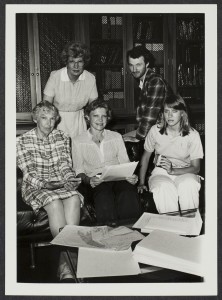Joyce Haguewood Lamont passed away on February 22, 2014. Read about her career and the words of her colleagues who have now moved on to roles at different institutions in the first post dedicated to her memory. Statements from more of her colleagues at The University of Alabama will conclude our third day of commemoration tomorrow.
Kevin Ray
The University of Alabama Libraries lost a very special lady on February 22, 2014. Joyce Haguewood Lamont, Assistant Dean for Special Collections, Emerita, passed away after a battle with cancer. Joyce was born in Choctaw County, Alabama, in 1932, and grew up in Tuscaloosa. A 1954 graduate of The University of Alabama, she began working in the library after graduation, first in the Business Library, and later in the acquisitions department in the Gorgas Library. Joyce became Curator of Special Collections in 1976. She retired in 1994.
I first met Joyce in 1990, when I transferred to The University of Alabama as an undergraduate history major. That fall semester I began working in Special Collections as a work-study student. When I graduated in 1993, Joyce hired me as a full-time staff member. After her retirement the following year, we remained in contact. For many of us who worked for her, Joyce was far more than a boss or a department head. She was friend and a trusted adviser.

Margarette Gooch, Nancy Sherar, Lynne Sherar, Joyce Lamont (top left) and Guy Hubbs in Gorgas Library at presentation and donation of the John Gorman Barr papers (1980s)
As Curator and Head of the William Stanley Hoole Special Collections Library, Joyce dedicated herself to building and expanding the collections housed there. Under her direction, the holdings in the Hoole Library grew tremendously, both in volume and in scope. She was instrumental in establishing the university archives and records management program. She successfully courted donors across the state of Alabama, and beyond. She worked with book dealers to purchase materials when funds were available. If Joyce knew of something that would improve the holdings in Special Collections she went after it, and usually, she got it. Joyce was known to say that she could use her southern accent and charm to get what she wanted, but she had more talents than those at her disposal. One of her best talents was the ability to connect to people in deep and lasting way. Joyce built Special Collections by building relationships.
Joyce was a people person. She could talk to anyone and she seemed to know everyone. She was interested in where people were from, who they knew, and who their family members were. She had a remarkable ability to remember details about people and she used that ability to her advantage. She could talk to someone from an obscure corner of rural Alabama, and before long the two of them would find out that they had a mutual acquaintance, or a mutual relative. By finding personal connections with donors and prospective donors, Joyce was able to add a human element to what was essentially a business transaction. What began as business could easily end up as a long-time friendship.
Joyce was a storyteller. Her stories were real life stories, although perhaps slightly embellished. They were usually hilarious, and always entertaining. Her personal adventures, and especially her misadventures, were often the subject of her stories. Taking a trip with Joyce was never dull and could easily result in a brand new story. Something always happened that would later become part of her storytelling repertoire. Joyce could capture and hold the listener’s attention. Whether she was speaking to a large group or talking one person, she was able to keep them interested in what she had to say. Her stories were interesting, and so was she.
Interesting people are memorable people, and Joyce was certainly memorable. She was never a wallflower. Her stories, her lively and engaging personality, and her genuineness made an impression on those who met her. It was hard to forget Joyce, and it was easy to tell others “You need to meet her.” People often heard about Joyce long before they actually met her. And people will still hear about Joyce for years to come. The memory of someone like her does not fade quickly and it, like the rest of her legacy, will continue.
As head of Special Collections, Joyce Lamont expanded the material holdings, increased the staff size, and enlarged the entire breadth of the operation. She built and sustained long-term relationships and lasting friendships. Building those relationships took much more than southern charm. It took patience, dedication, and a skill set for dealing with people from a wide range of backgrounds. Her ability to connect with the people she met served her, and The University of Alabama Libraries, well. She will be deeply missed, but she will also be warmly remembered.


One Response to Remembering Joyce Lamont, Part II